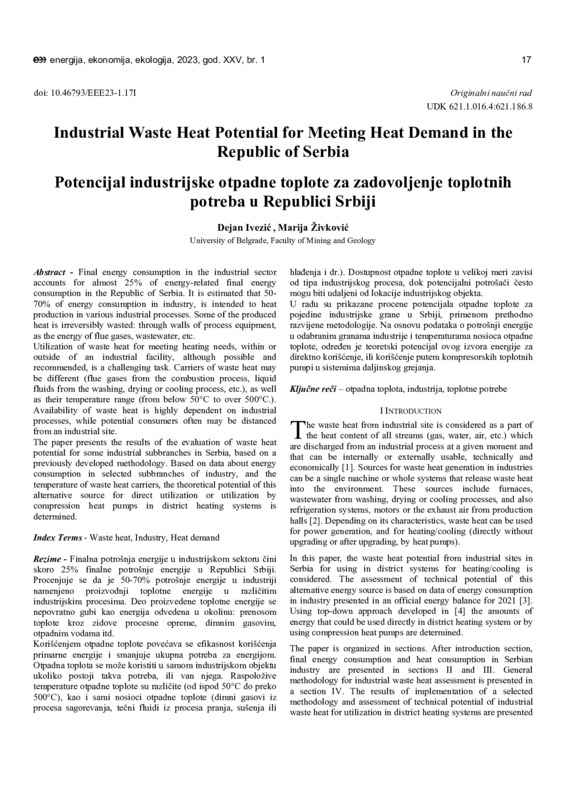Industrial Waste Heat Potential for Meeting Heat Demand in the Republic of Serbia
Објеката
- Тип
- Рад у часопису
- Верзија рада
- објављена верзија
- Језик
- српски
- Креатор
- Dejan Ivezić, Marija Živković
- Извор
- Energija, ekonomija, ekologija
- Датум издавања
- 2023
- Сажетак
- Finalna potrošnja energije u industrijskom sektoru čini skoro 25% finalne potrošnje energije u Republici Srbiji. Procenjuje se da je 50-70% potrošnje energije u industriji namenjeno proizvodnji toplotne energije u različitim industrijskim procesima. Deo proizvedene toplotne energije se nepovratno gubi kao energija odvedena u okolinu: prenosom toplote kroz zidove procesne opreme, dimnim gasovim, otpadnim vodama itd. Korišćenjem otpadne toplote povećava se efikasnost korišćenja primarne energije i smanjuje ukupna potreba za energijom. Otpadna toplota se može koristiti u samom industrijskom objektu ukoliko postoji takva potreba, ili van njega. Raspoložive temperature otpadne toplote su različite (od ispod 50°C do preko 500°C), kao i sami nosioci otpadne toplote (dimni gasovi iz procesa sagorevanja, tečni fluidi iz procesa pranja, sušenja ili hlađenja i dr.). Dostupnost otpadne toplote u velikoj meri zavisi od tipa industrijskog procesa, dok potencijalni potrošači često mogu biti udaljeni od lokacije industrijskog objekta. U radu su prikazane procene potencijala otpadne toplote za pojedine industrijske grane u Srbiji, primenom prethodno razvijene metodologije. Na osnovu podataka o potrošnji energije u odabranim granama industrije i temperaturama nosioca otpadne toplote, određen je teoretski potencijal ovog izvora energije za direktno korišćenje, ili korišćenje putem kompresorskih toplotnih pumpi u sistemima daljinskog grejanja.
- Final energy consumption in the industrial sector accounts for almost 25% of energy-related final energy consumption in the Republic of Serbia. It is estimated that 50- 70% of energy consumption in industry, is intended to heat production in various industrial processes. Some of the produced heat is irreversibly wasted: through walls of process equipment, as the energy of flue gases, wastewater, etc. Utilization of waste heat for meeting heating needs, within or outside of an industrial facility, although possible and recommended, is a challenging task. Carriers of waste heat may be different (flue gases from the combustion process, liquid fluids from the washing, drying or cooling process, etc.), as well as their temperature range (from below 50°C to over 500°C.). Availability of waste heat is highly dependent on industrial processes, while potential consumers often may be distanced from an industrial site. The paper presents the results of the evaluation of waste heat potential for some industrial subbranches in Serbia, based on a previously developed methodology. Based on data about energy consumption in selected subbranches of industry, and the temperature of waste heat carriers, the theoretical potential of this alternative source for direct utilization or utilization by compression heat pumps in district heating systems is determined.
- том
- XXV
- Број
- 1
- почетак странице
- 17
- крај странице
- 23
- doi
- 10.46793/EEE23-1.17I
- issn
- 0354-8651
- Subject
- otpadna toplota, industrija, toplotne potrebe
- Waste heat, Industry, Heat demand
- Шира категорија рада
- M50
- Ужа категорија рада
- М52
- Права
- Отворени приступ
- Лиценца
- Creative Commons – Attribution-NonComercial-Share Alike 4.0 International
- Формат
Dejan Ivezić, Marija Živković. "Industrial Waste Heat Potential for Meeting Heat Demand in the Republic of Serbia" in Energija, ekonomija, ekologija (2023). https://doi.org/10.46793/EEE23-1.17I М52
This item was submitted on 2. новембар 2023. by [anonymous user] using the form “Рад у часопису” on the site “Радови”: http://romeka.rgf.rs/s/repo
Click here to view the collected data.
